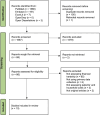Financial hardship among patients suffering from neglected tropical diseases: A systematic review and meta-analysis of global literature
- PMID: 38739636
- PMCID: PMC11090293
- DOI: 10.1371/journal.pntd.0012086
Financial hardship among patients suffering from neglected tropical diseases: A systematic review and meta-analysis of global literature
Abstract
Introduction: Neglected tropical diseases (NTDs) mainly affect underprivileged populations, potentially resulting in catastrophic health spending (CHS) and impoverishment from out-of-pocket (OOP) costs. This systematic review aimed to summarize the financial hardship caused by NTDs.
Methods: We searched PubMed, EMBASE, EconLit, OpenGrey, and EBSCO Open Dissertations, for articles reporting financial hardship caused by NTDs from database inception to January 1, 2023. We summarized the study findings and methodological characteristics. Meta-analyses were performed to pool the prevalence of CHS. Heterogeneity was evaluated using the I2 statistic.
Results: Ten out of 1,768 studies were included, assessing CHS (n = 10) and impoverishment (n = 1) among 2,761 patients with six NTDs (Buruli ulcer, chikungunya, dengue, visceral leishmaniasis, leprosy, and lymphatic filariasis). CHS was defined differently across studies. Prevalence of CHS due to OOP costs was relatively low among patients with leprosy (0.0-11.0%), dengue (12.5%), and lymphatic filariasis (0.0-23.0%), and relatively high among patients with Buruli ulcers (45.6%). Prevalence of CHS varied widely among patients with chikungunya (11.9-99.3%) and visceral leishmaniasis (24.6-91.8%). Meta-analysis showed that the pooled prevalence of CHS due to OOP costs of visceral leishmaniasis was 73% (95% CI; 65-80%, n = 2, I2 = 0.00%). Costs of visceral leishmaniasis impoverished 20-26% of the 61 households investigated, depending on the costs captured. The reported costs did not capture the financial burden hidden by the abandonment of seeking healthcare.
Conclusion: NTDs lead to a substantial number of households facing financial hardship. However, financial hardship caused by NTDs was not comprehensively evaluated in the literature. To develop evidence-informed strategies to minimize the financial hardship caused by NTDs, studies should evaluate the factors contributing to financial hardship across household characteristics, disease stages, and treatment-seeking behaviors.
Copyright: © 2024 Patikorn et al. This is an open access article distributed under the terms of the Creative Commons Attribution License, which permits unrestricted use, distribution, and reproduction in any medium, provided the original author and source are credited.
Conflict of interest statement
I have read the journal’s policy and the authors of this manuscript have the following competing interests:XXH works for the World Health Organization. The author alone is responsible for the views expressed in this publication and does not necessarily represent the decisions, policies, or views of the World Health Organization.
Figures



References
-
- World Health Organization. Ending the neglect to attain the Sustainable Development Goals: a road map for neglected tropical diseases 2021–2030. Geneva: World Health Organization; 2020.
-
- World Health Organization. Neglected tropical diseases, hidden successes, emerging opportunities. 2009. World Health Organization, Geneva. 2014.
-
- Aagaard-Hansen J, Chaignat CL. Neglected tropical diseases: equity and social determinants. Equity, social determinants and public health programmes. 2010;135(1):303.
-
- World Health Organization. Distribution of health payments and catastrophic expenditures methodology. World Health Organization; 2005.
-
- Wagstaff A. Measuring financial protection in health: World Bank Publications; 2008.
Publication types
MeSH terms
Grants and funding
LinkOut - more resources
Full Text Sources

